The story of the last surviving wild Siberian Crane (Omid) and Roya
Guest blog by Keramat Hafezi Birgani
The Siberian Crane is a critically endangered species of birds. There used to be three populations, of which the ‘central’ population was already extinct by 2002.
Omid (in Persian “hope”) is the only known survivor of the Western population of Siberian cranes in the wild. He is the only Siberian crane in the world who retains the ancient knowledge of the migration route and timing of the western population. The survival of this population and the preservation of this migration flyway in the wild, all depend on Omid. Siberian cranes are on the verge of extinction due to various reasons especially hunting.
A group of Siberian Cranes was discovered by Dr. Ali Ashtiani in 1978. They numbered 12‒14 cranes and inhabited a wetland complex where local people trapped wild ducks and geese. In 1985, Russian colleague Dr. Yuri Markin, discovered new breeding grounds by attaching a satellite transmitter to a male crane in Iran. During the 1990s, the population declined. For 15 years, only a single male named Omid appeared each autumn in Iran.
Paying attention to these points has provoked us humans to do our best to preserve Omid and increase Siberian cranes of the western population in the wild, an effort that has not been successful in the past years.
No one knows the exact age of the bird, but Omid has been observed for less than fifteen years. In captivity, their lifespan has been recorded up to about 70 years.
We hope that Omid will have a long life and that our human efforts will be helpful for the survival of its generation, but nature is full of challenges and dangers, and its survival so far is a miracle and a cause for hope.
Humans and ecosystem changes brought him to the brink of extinction, but will humans be able to help him? We are doing our best to retain our hope and we are organising an international effort with the most expert and experienced people in the world in the field of Siberian cranes.
Omid usually spends four months in the Fereydounkenar wetland by the Caspian Sea in Northern Iran. His migration path is about five thousand kilometres and there are many dangers for Siberian cranes on this route. But the continued presence of Omid in a certain area every winter has made it possible to protect and help him, at least when he is in Iran (Fig. 1).
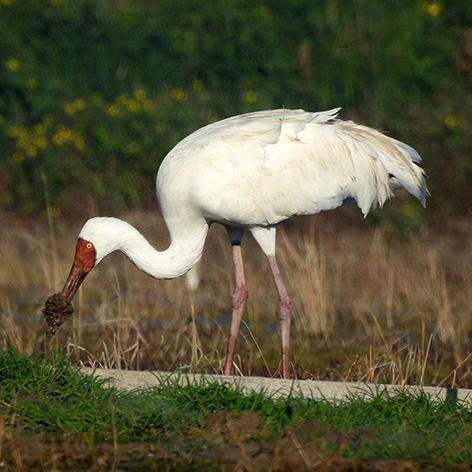
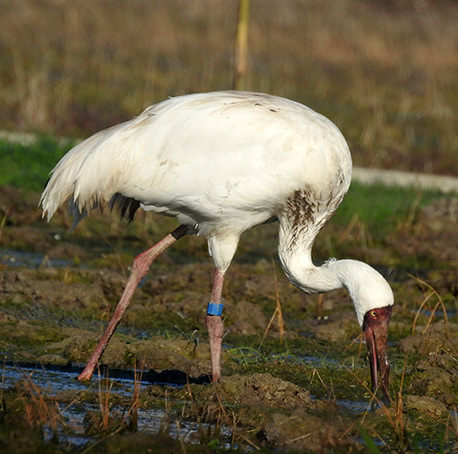
In the last year, my friend George Archibald, Co-founder of the International Crane Foundation (the ICF), informed me that there was a suitable Siberian Crane female in Belgium, available to accompany Omid on his migrations. I then established a relationship between the Cracid & Crane Breeding and Conservation Center (CBCC) in Belgium and the Department of Environment (DoE) of the Islamic Republic of Iran. We informed the Vice-President and Head of the DoE, Ali Salajegheh. Plans were made at the highest level of the DoE to save Omid and maintain the flyway so that, in this way, the bird transfer operation began.
As soon as the CBCC was introduced and the contact with a Siberian crane exporter was made, the necessary measures were taken to obtain permits from the CBCC and the DoE. However, the spread of avian flu in Europe made it more difficult, complicated, and time-consuming to get the proper permits.
Many measures and numerous international permits were needed to transfer a Siberian Crane to Iran with the participation of the DoE and the CBCC. Roya (whose name means “Dream” in Persian) was the female Siberian Crane presented in perfect health by the CBCC to the DoE (Fig. 2).
Geer Scheres from the CBCC was always by our side and contributed his counsel and experience, earning our appreciation as he continues to help us.
The transportation and planned release of Roya was described as “a big step for the survival of the species” by Geer Scheres. “The intention is to save part of an already very small population.”
The ICF has been working for 50 years with the advice of experts and scientists from different parts of the world for the protection and survival of Siberian cranes and has a lot of experience in this field. For this reason, we asked George Archibald to help us with this project, and he also provided advice for this action in Iran. The DoE is the main party responsible for this project in Iran, and they have made a valiant and valuable effort.
The CBCC, with many years of experience in breeding Siberian cranes and endangered species, opened and maintained valuable communication and cooperation with the DoE. They gave Roya, a beautiful Siberian crane to Iran’s nature, and throughout the whole process, provided valuable experience and advice.
After Roya’s arrival in Iran, she was placed in the release structure. A special cage was placed near Omid’s habitat so that the release could be done slowly and gradually after observing the possible desire of the two birds.
After seeing two Siberian Cranes together and observing the interaction and sounds, and behavior of Roya and Omid, Roya was released. From the very first moments, both Siberian Cranes danced together and soon, the birds started to fly, explore the environment, and feed on the wetland (Fig. 3).
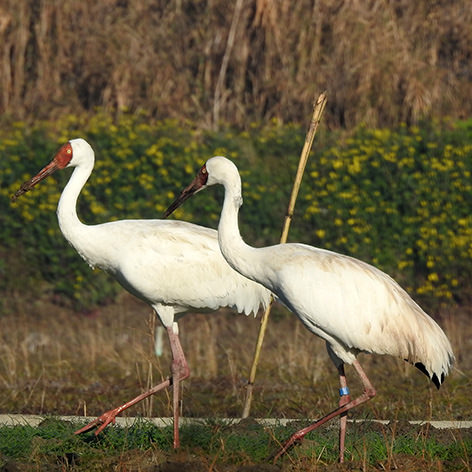
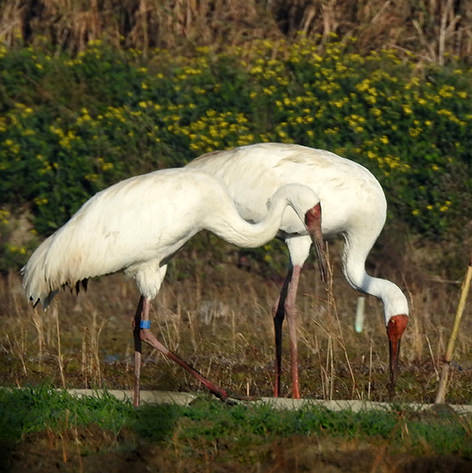
Report on the meeting of Omid and Roya by Keramat Hafezi Birgani, Koros Rabiei
January 31, 2023; 9:41 am – report setting time; release site is Ojakeleh, Fereydonkener, Mazandaran Province, Iran.
Omid approached the release structure early in the morning. The weather was foggy; 7:03 Omid was about 30 meters from Roya. At 7:15, with the name and remembrance of God and prayers for the best, the door was slowly opened. At 7:23 a.m., Roya left the cage very calmly and without flying and went towards Omid; Omid and Roya fed together.
At 7:50, they danced and sang together for the first time in the beautiful plains of the Caspian Sea in northern Iran.
At 7:57, Roya flew about 200-300 meters, and Omid quickly walked towards her. They stayed for a few minutes and then flew 300 meters. Now Omid and Roya are about 200 meters apart; Roya is preening her feathers.
Everything is excellent; we wish everything continues to go well!
The environmental rangers and I monitored Roya and Omid day and night.
In the early days of releasing the bird Omid came from north of the wetland to see Roya and stayed only a few hours, but their time together increased every day, so that in the following days, both birds were together all day and night, and Roya even flew with Omid at night and went to roost in the northern areas of the wetland (Fig. 4).
Roya, a seven-year-old crane, was fresh and brave against natural hazards (Fig. 5). This Siberian crane had little contact with humans. On the other hand, her vigilance and natural instinct were also very excellent, so that after soft release, she was completely alert and fresh; she was feeding on food from the appropriate environment, and also adapted against challenges such as the night, the fog and the dangers of wildlife. She bravely adapted to the conditions of nature and benefited from Omid’s training. Siberian cranes of the CBCC are descendants of the cranes of the western population of Russia, which in the past were used by the CBCC and the ICF to preserve the survival of this species in the world.
In the pictures, I recorded some of the dangers of wildlife, which we observed during round-the-clock monitoring after the release of Roya. Carnivores such as a large number of Golden Jackals (Fig. 6) (due to the proximity of the Hyrcanian forest patches), Jungle Cat, Eurasian Otter (at night), as well as birds of prey such as the White-tailed Sea Eagle, Greater Spotted Eagle (Fig. 7), Eastern Imperial Eagle, Northern Goshawk, and Black Kite were some of the powerful birds of prey in the wintering area of Roya and Omid.
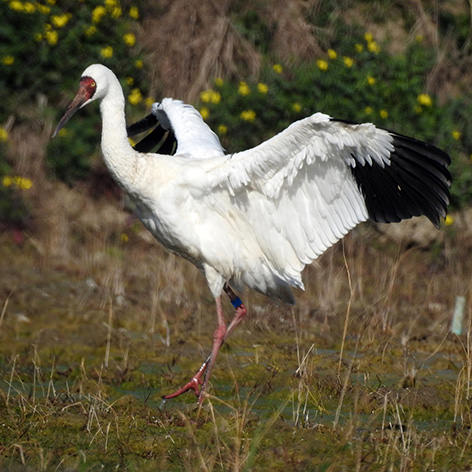
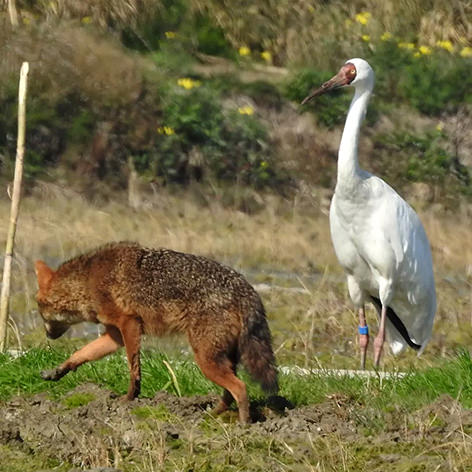
There are many natural and artificial dangers facing migratory birds; we hope that with the grace of God Almighty, they will overcome these dangers with good health, and that they will be responsible for the survival of the western population of the Siberian cranes of the world, and that Roya will also learn the knowledge of migration from Omid.
In the days close to the time of migration, they flew together around the wetland. They danced and called.
On 5 March, in the morning, the Siberian Crane pair ‒ Omid and Roya, started spring migration to the north. Together, they passed the Sorkhrood Lagoon. The weather was sunny and calm.
According to the DoE of the Mazandaran Province, two Siberian cranes began their long and perilous flight from Fereydunkenar wetland to Western Siberia.
“Omid arrived in Iran on October 27, and after 130 days of wintering in northern Iran’s wetland, it left the resort for Siberia accompanied by Roya who spent 34 days with him,” Ata’ollah Kavian, the Di-rector-General of the DoE of the northern province of Mazandaran, was quoted Omid has spent winters in Iran consecutively for the past 15 years, even after he lost his mate Arezoo (meaning ‘wish’ in Persian) (Fig. 8).
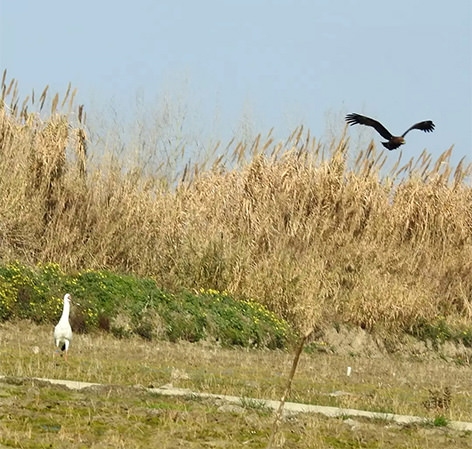
After the start of the first migration of Omid with Roya, Roya was seen alone on the migration route, but she was healthy and was captured on March 12, 2023.
Iranian colleagues of the DoE of Mazandaran Province handle Roya in a safe manner. Roya was successfully captured and is being kept in Iran to have the opportunity to be with Omid again next autumn in 2023. We hope that they will be successful in the second migration.
Now Roya is in perfect health in Iran and is waiting for Omid’s return in autumn.
The efforts to find Omid by our Russian colleagues continue, and if the exact location of Omid in Siberia is determined, our Russian colleagues have announced their readiness to release young Siberian cranes from the Oka Crane Breeding Centre in Ryazan Region into Omid’s summering area, but of course, Omid has not yet been observed in the vast summering area. For this reason, all the past actions of the ICF and Russian colleagues have focused on Iran to save the Western population.
The CBCC has also announced its readiness to donate the Siberian cranes that will be born this summer to Iran to be released in the wintering area in the north of Iran in autumn 2023, and thus all scientific efforts will be made for the survival of the western population of the Siberian crane. Of course, all these measures depend on the observation and return of Omid, and we and the world’s Siberian crane experts are doing our best, and we maintain our hope.
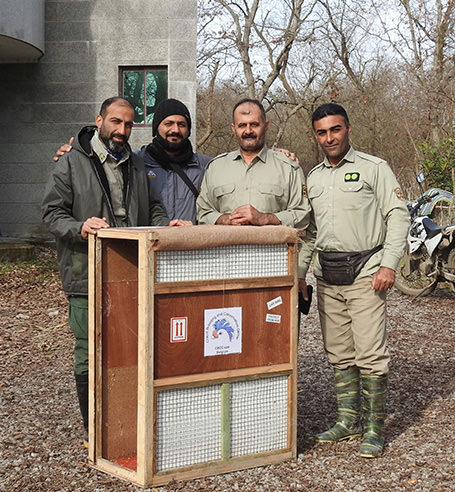
Fig. 8. Keramat Hafezi Birgani (the second from the left) and rangers of the Department of Environment of Mazandaran Province (from the left to the right): Mojtaba Alizadeh, Ali Shirgahi, and Abdollah Dadbin with the empty transfer box from the CBCC Belgium in Fereydounkenar – the wintering site of Omid in Mazandaran Province, Iran
Reproduced with kind permission from the Middle East Crane Conservation Group Newsletter No. 1, 2023

Hi there,
Is there any news about Omid? I hope his story continues. Projects like this, give me hope in these troubeled times.